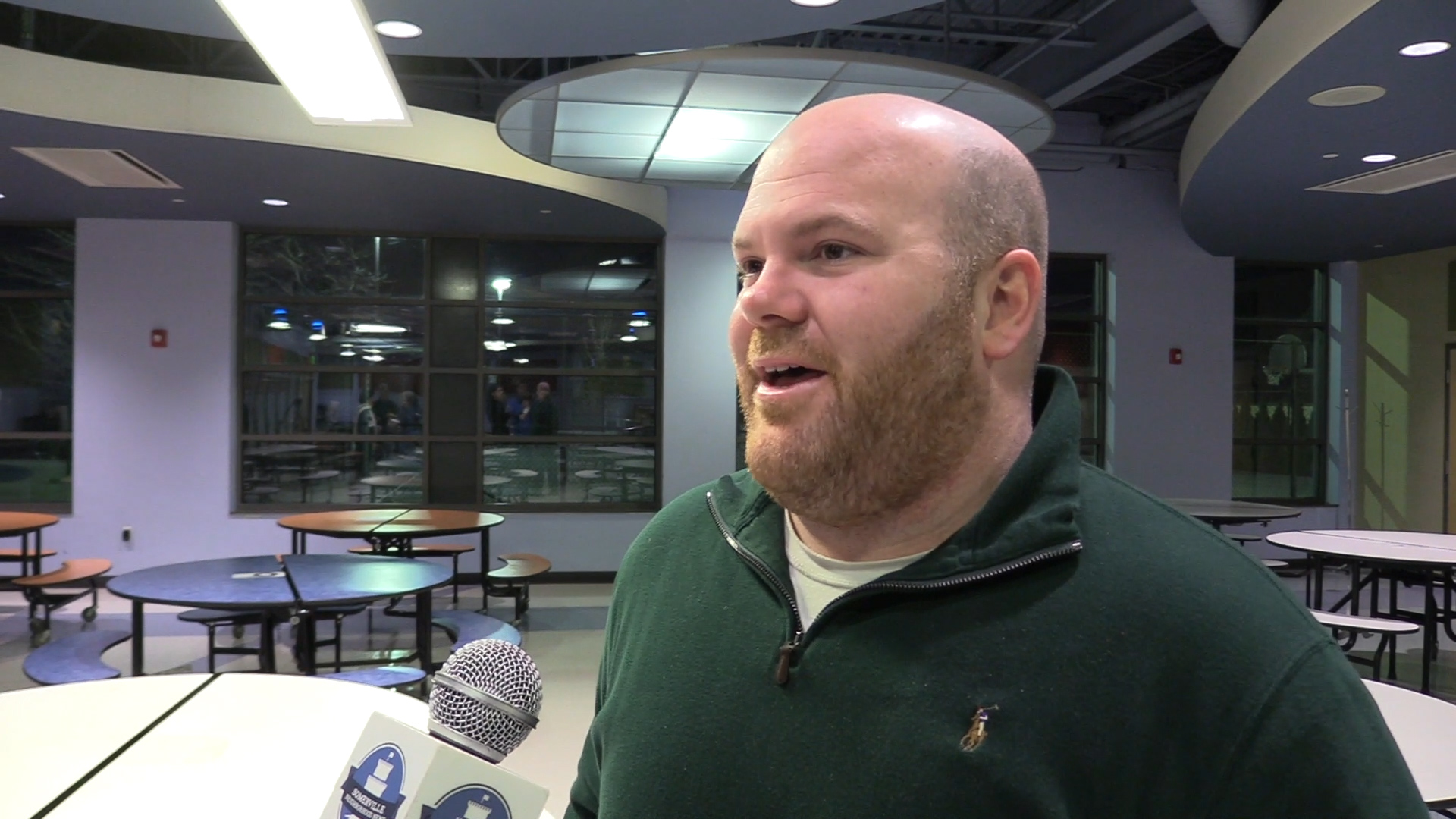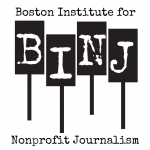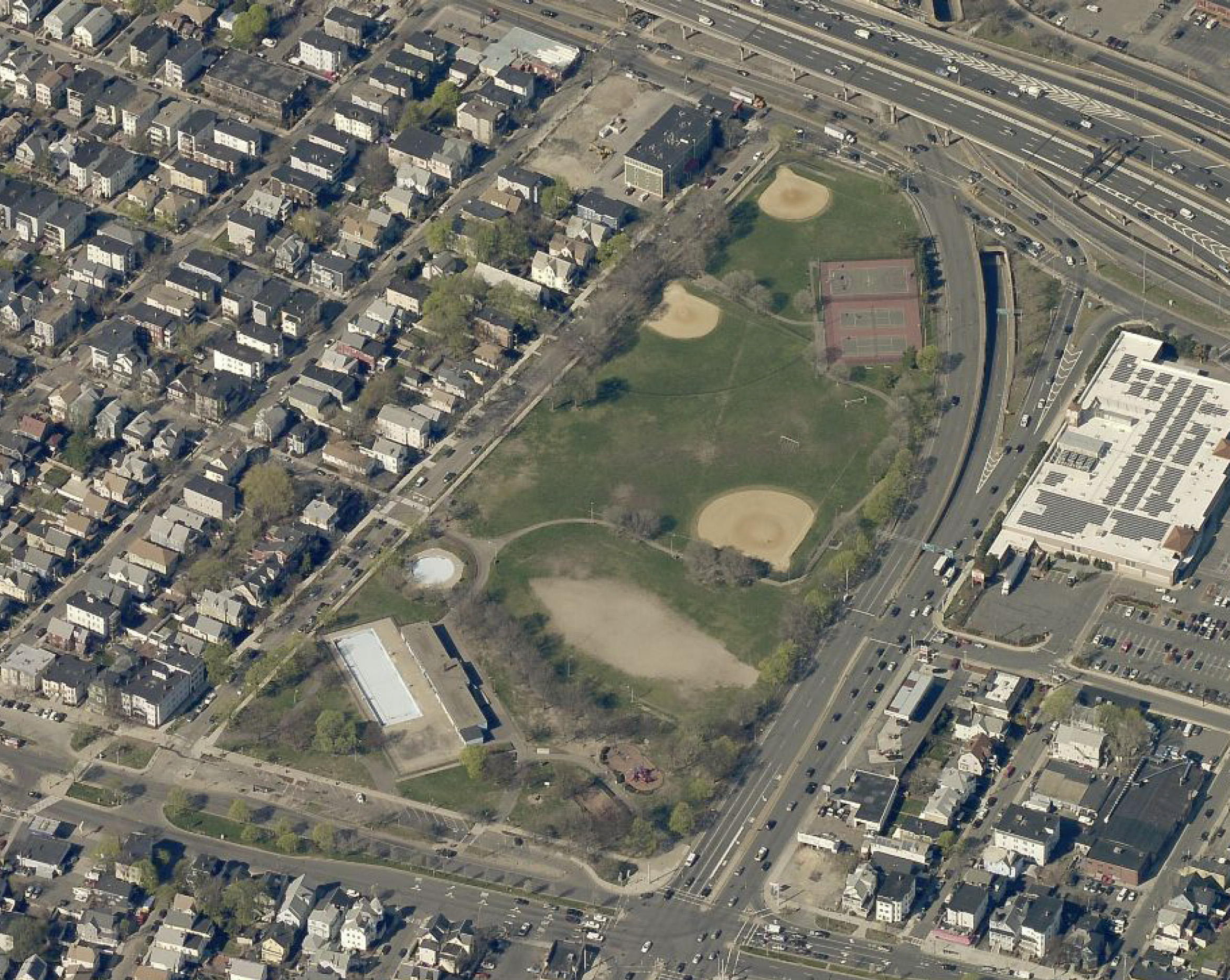Aerial view of Foss Park from 2019 Foss Park Community Meeting Kickoff
Somerville has scant green space, but who will maintain the little there is?
Somerville residents agree with city and state officials that Foss Park, one of the city’s biggest open spaces, needs a facelift. And likely much more, as anyone who has played ball or walked a dog there knows about the dust bowls, lack of drainage, and other challenges.
Last year, the state announced a $1.2 million-dollar project that includes building a new artificial turf field, plus adding field lighting and completing walkway upgrades and drainage improvements.
But what else is in the works? And what else is possible?
The field is only one feature of the nearly 14-acre park, which is owned by the state Department of Conservation and Recreation (DCR). It also has a pool, a playground, basketball and tennis courts, several baseball diamonds, and other open spaces.
Earlier this fall, city officials and state representatives hosted two meetings to hear from residents about what additional kinds of improvements or changes they might like to see. The goal of the summits was to “gather community feedback” so that “elected officials and staff can continue to advocate for improvements to be made that reflect the needs of our entire community,” according to Jacklyn Rossetti, Somerville deputy director of communications.
“Advocate” is the key word. At the moment, the only improvements actually planned for and funded are the state’s updates to the playing field.
“We are getting that field, which is a really great thing, but that’s all we’re getting right now,” Ward 1 City Councilor Matthew McLaughlin said in an interview. “There’s no real funding mechanism right now to address all the concerns besides the field.”
About 20 people showed up at a November meeting at the East Somerville Community School to discuss the topic. The city had translators on hand for Haitian Creole-, Spanish- and Portuguese-speaking residents, but as the meeting proceeded, nobody from those communities appeared to be present (officials promised to do further outreach).

Luisa Oliveira, Somerville’s new director of public space and urban forestry, launched the meeting by addressing the park’s history, in the process noting some of the multiple challenges on hand. For one, the park is surrounded by highways on three sides. Also, about 16% of the park’s 113 trees are dead (2) or in poor condition (16), while the ash trees are being menaced by the Emerald ash borer beetle.
For almost 90 minutes, different city staffers addressed various major issues—playing fields and other sports-related installations, the natural environment, and traffic—and recorded notes as people weighed in.
Among the things acknowledged by participants: the need for dog-friendly spaces, more trees, and even a pathway that reaches the nearby Stop & Shop supermarket. Pool users asked for more shade, while a tennis player noted that the city has far too few courts, and that those that do exist are underused as a result of poor maintenance. Some asked for locker rooms, water fountains, and seating by the fields and bathrooms. A few residents stressed the need for grass rather than more turf, a running battle in these parts, and also requested more natural space in general. A few mentioned problems, such as discarded syringes and trash.
Pop Warner President Roger Desrochers, who oversees five football and cheerleading teams that use the facilities, made the case for more turf fields that can be played on for more hours than grass, and which recover more quickly after rainfall.
“We’re building this huge great city here in Somerville that is bringing families from all around,” Desrochers told the room. “If you build this park to where people will be proud, you’re going to bring more and more kids and our youth programs are going to start to build up again.”
“We have a lot of youth sports in this city that should be using it,” Desrochers later said in an interview. “There’s no other big park in the city, rectangular, that our team can use. My kids haven’t had a goal post to practice kicks in 10 years.”
As the meeting wound down, one woman asked, “Is there more money available?”
State Sen. Pat Jehlen, seated beside Rep. Mike Connolly, acknowledged that DCR did not have “a lot of money,” but added that there may be funding for some of the less expensive suggestions, although not “next year.” Connolly agreed, saying that the state budget is “in a state of austerity,” but that the meeting was important because the ideas aired will “help us understand how we can advocate.”
The lack of funding for improvements, said McLaughlin, who represents the ward in which Foss Park is located, said the lack of funding was “the elephant in the room.”
“Who’s paying for this, and who’s owning the property after it’s paid for?” he asked. “If we’re going to put millions of dollars into this property, we have to have some say in what goes on with it.”
“The City would like to make improvements to Foss park in partnership with DCR to better serve residents,” Rossetti wrote in an email. “Dilboy and Foss are are our largest parks and as a densely populated community we have a significant interest in improvements made to both facilities. This is why we continue to work closely with our state partners and advocate for improvements that will best meet the needs of our community.”
After the November meeting, McLaughlin said that he is willing to entertain a plan in which the city funds some improvements, but only if it comes with more control.
“I don’t want us to spend $10 million for trees or something and then the trees die and we need DCR to take care of it,” he said. “Everything we put in financially, we need to be able to have control over.”
Somerville’s Public Space and Urban Forestry Division is drafting a report based on feedback from two meetings on this issue that have taken place so far.
Story published in collaboration with Somerville Neighborhood News.









